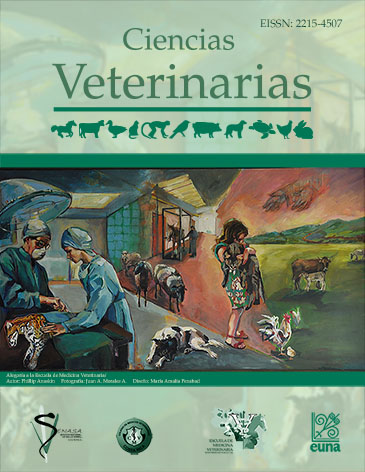Nosemosis in Africanized Honey Bee Colonies (Apis mellifera) in the Tropical Conditions of Costa Rica: Nosema apis or Nosema ceranae
DOI:
https://doi.org/10.15359/rcv.39-2.3Keywords:
Nosema apis, Nosema ceranae, nosemosis, Africanized honey bees, Costa RicaAbstract
The presence of nosemosis in Africanized honey bees in Costa Rica was studied. A total of 75 samples of adult bees from different country regions were selected for molecular diagnosis of nosemosis. Prior to PCR tests, Nosema spp. spores were morphologically identified in most of the bee samples using a light microscopy at 40x magnification. According to molecular analyses, most of the bee samples were found to be infected with Nosema ceranae. However, colonies showed no clinical signs of infection at any time during the sampling period, none of them being infected with Nosema apis. Surprisingly, 29.3% of the bee samples tested PCR negative to nosemosis. The origin of the bee samples collected from apiaries located in four of the seven provinces of Costa Rica showed the microsporidium is widely spread throughout the main beekeeping areas of the country. The pathological consequences of N. ceranae in Africanized honey bee colonies have not been well determined. Because of reports of honey bee colony losses in Europe related to microsporidian infections, the virulence of N. ceranae in Africanized honey bees needs to be studied.
References
Botías, C., Martín, R., Meana, A. & Higes, M. (2012). Critical aspects of the Nosema spp. diagnostic sampling in honeybee (Apis mellifera L.) colonies. Parasitology Research, 110, 2557-2561. doi.10.1007/s00436-011-2760-2
Calderón, R. A., Sánchez, L. A., Yañez O. & Fallas N. (2008). Presence of Nosema ceranae in Africanized honey bee colonies in Costa Rica. Journal of Apicultural Research and Bee World, 47(4), 328-329. http://dx.doi.org/10.1080/00218839.2008.11101485
Calderón, R. A. & Ramírez, F. (2013). Enfermedades de las abejas melíferas, con énfasis en abejas africanizadas. EUNA. Heredia, Costa Rica
Chemurot, M., De Smet, L., Brunain, M., De Rycke, R. & De Graaf, D. (2017). Nosema neumanni (Microsporidia, Nosematidae), a new microsporidian parasite of honeybees, Apis mellifera in Uganda. European Journal of Protistology, 61, 13-19. doi.10.1016/j.ejop.2017.07.002
Chen, Y., Evans, J. D., Smith, I. B. & Pettis J. S. (2008). Nosema ceranae is a long-present and wide-spread microsporidian infection of the European honey bee (Apis mellifera) in the United States. Journal of Invertebrate Pathology, 97(2), 186-188. doi:10.1016/j.jip.2007.07.010
Chen, Y. P. & Huang, Z. Y. (2010). Nosema ceranae, a newly identified pathogen of Apis mellifera in the USA and Asia. Apidologie, 41, 364-374. https://doi.org/10.1051/apido/2010021
Cornejo, L. G. & Rossi, C. O. (1975). Enfermedades de las abejas, su profilaxis y prevención. Hemisferio Sur. Buenos Aires.
Cueto, S. A., López, G., Orozco, C., Gómez, S. D., Moreno, K., Espinoza, K. O., Guerrero, J. G., Silva, L. E., Trasviña, E. & Monge, F. J. (2020). Prevalence and geographical distribution of Nosema apis and Nosema ceranae in apiaries of Northwest of Mexico using a duplex real time PCR with melting curve. Journal of Apicultural Research, 59(2), 195-203. https://doi.org/10.1080/00218839.2019.1676999
Fleites, F., Quezada, J. & Medina, L. (2018). Onset of foraging and lifespan of Africanized honey bees (Apis mellifera) infected with different levels of Nosema ceranae spores in Neotropical Mexico. Apidologie, 49, 781-788. doi:10.1007/s13592‐018‐0602‐2
Fries, I., Feng, F., Da Silva, A., Slemenda, B. & Pieniazek, J. (1996). Nosema ceranae n. sp. (Microspora, Nosematidae). Morphological and molecular characterization of a microsporidian parasite of the Asian honey bee Apis ceranae (Hymenoptera, Apidae). European Journal of Protistology, 32, 356-365. https://doi.org/10.1016/S0932-4739(96)80059-9
Fries, I. (2010). Nosema ceranae in European honeybees (Apis mellifera). Journal of Invertebrate Pathology, 103, S73-S79. https://doi.org/10.1016/j.jip.2009.06.017
Furgala, B. & Hyser, R. A. (1969). Minnesota Nosema survey. American Bee Journal 109, 460-461.
Giersch, T., Berg, T., Galea, F. & Hornitzky, M. (2009). Nosema ceranae infects honey bees (Apis mellifera) and contaminates honey in Australia. Apidologie, 40, 117-123. doi:10.1051/apido/2008065
Guzman-Novoa, E., Hamiduzzaman, M., Arechavaleta-Velazco, M. E., Koleuglu, G., Valizadeh, P. & Correa-Benitez, A. (2011). Nosema cerenae has parasite Africanized honey bees in Mexico since at least 2004. Journal of Apicultural Research, 50(2), 167-169. doi:10.3896/IBRA.1.50.2.09
Higes, M., Martin, R. & Meana, A. (2006). Nosema ceranae, a new microsporidian parasite in honey bees in Europe. Journal of Invertebrate Pathology, 92, 93-95. doi:10.1016/j.jip.2006.02.005
Higes, M., Martín-Hernández, R., Botías, C., Garrido-Bailón, E., González-Porto, A. V., Barrios, L., Nozal, M., Bernal, J. L., Jiménez, J. J., García-Palencia, P. & Meana, A. (2008). How natural infection by Nosema ceranae causes honeybee colony collapse. Environmental Microbiology, 10, 2659-2669. doi: 10.1111/j.1462-2920.2008.01687.x
Huang, W. F., Jiang, J. H., Chen, Y. W. & Wang, C. H. (2007). A Nosema ceranae isolate from the honeybee Apis mellifera. Apidologie, 38, 30-37. https://doi.org/10.1051/apido:2006054
Klee, J., Besana, A. M., Genersch, E., Gisder, S., Nanetti, A., Tam, D. Q., Chinh, T. X., Puerta, F., Ruz, J. M., Kryger, P., Message, D., Hatjina, F., Korpela, S., Fries, I. & Paxton, R. J. (2007). Widespread dispersal of the microsporidian Nosema ceranae, an emergent pathogen of the western honey bee, Apis mellifera. Journal of Invertebrate Pathology, 96, 1-10. doi:10.1016/j.jip.2007.02.014
Martin-Hernández, R., Meana, A., Prieto, L., Salvador, A. M., Garrido-Bailón, E. & Higes, M. (2007). Outcome of colonization of Apis mellifera by Nosema ceranae. Applied Environmental Microbiology, 73, 6331-6338. doi:10.1128/AEM.00270-07
Matheson, A. (1993). World bee health report. Bee World, 74, 176-212. https://doi.org/10.1080/0005772X.1993.11099183
Moritz, R., De Miranda, J., Fries, I., Le Conte, Y., Neumann, P. & Paxton R. (2010). Research strategies to improve honeybee health in Europe. Apidologie, 41, 227-242. https://doi.org/10.1051/apido/2010010
Paxton, R., Klee, J., Korpela, S. & Fries, I. (2007). Nosema ceranae has infected Apis mellifera in Europe since at least 1998 and may be more virulent than Nosema apis. Apidologie, 38, 558-565. https://doi.org/10.1051/apido:2007037
Ritter, W. (2001). Enfermedades de las abejas. Acribia S.A. Zaragoza.
Shimanuki, H. & Knox D. A. (2000). Diagnosis of honey bee diseases. Department of Agriculture, Agriculture Handbook.
Spivak, M. (1991). The Africanization process in Costa Rica. Westview Press Inc. Boulder, CO.
Texeira, E. W., Guimaraes, L., Sattler, A., Message, D., Teles, M. L., Fonseca, M., Lopes, M. & Mauricio, T. (2013). Nosema ceranae has been present in Brazil for more than three decades infecting Africanized honey bees. Journal of Invertebrate Pathology, 114, 250-254. doi:10.1016/j.jip.2013.09.002
Traver, B. & Fell, R. (2011). Prevalence and infection intensity of Nosema in honeybee (Apis mellifera L.) colonies in Virginia. Journal of Invertebrate Pathology, 107, 43-49. doi:10.1016/j.jip.2011.02.003
Published
How to Cite
Issue
Section
License
Licensing of articles
All articles will be published under a license:

Licencia Creative Commons Atribución-NoComercial-SinDerivadas 3.0 Costa Rica.
Access to this journal is free of charge, only the article and the journal must be cited in full.
Intellectual property rights belong to the author. Once the article has been accepted for publication, the author assigns the reproduction rights to the Journal.
Ciencias Veterinarias Journal authorizes the printing of articles and photocopies for personal use. Also, the use for educational purposes is encouraged. Especially: institutions may create links to specific articles found in the journal's server in order to make up course packages, seminars or as instructional material.
The author may place a copy of the final version on his or her server, although it is recommended that a link be maintained to the journal's server where the original article is located.
Intellectual property violations are the responsibility of the author. The company or institution that provides access to the contents, either because it acts only as a transmitter of information (for example, Internet access providers) or because it offers public server services, is not responsible.







